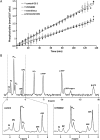Reduced phosphocholine and hyperpolarized lactate provide magnetic resonance biomarkers of PI3K/Akt/mTOR inhibition in glioblastoma
- PMID: 22156546
- PMCID: PMC3280799
- DOI: 10.1093/neuonc/nor209
Reduced phosphocholine and hyperpolarized lactate provide magnetic resonance biomarkers of PI3K/Akt/mTOR inhibition in glioblastoma
Abstract
The phosphatidylinositol-3-kinase/Akt/mammalian target of rapamycin (PI3K/Akt/mTOR) signaling pathway is activated in more than88% of glioblastomas (GBM). New drugs targeting this pathway are currently in clinical trials. However, noninvasive assessment of treatment response remains challenging. By using magnetic resonance spectroscopy (MRS), PI3K/Akt/mTOR pathway inhibition was monitored in 3 GBM cell lines (GS-2, GBM8, and GBM6; each with a distinct pathway activating mutation) through the measurement of 2 mechanistically linked MR biomarkers: phosphocholine (PC) and hyperpolarized lactate.(31)P MRS studies showed that treatment with the PI3K inhibitor LY294002 induced significant decreases in PC to 34 %± 9% of control in GS-2 cells, 48% ± 5% in GBM8, and 45% ± 4% in GBM6. The mTOR inhibitor everolimus also induced a significant decrease in PC to 62% ± 14%, 57% ± 1%, and 58% ± 1% in GS-2, GBM8, and GBM6 cells, respectively. Using hyperpolarized (13)C MRS, we demonstrated that hyperpolarized lactate levels were significantly decreased following PI3K/Akt/mTOR pathway inhibition in all 3 cell lines to 51% ± 10%, 62% ± 3%, and 58% ± 2% of control with LY294002 and 72% ± 3%, 61% ± 2%, and 66% ± 3% of control with everolimus in GS-2, GBM8, and GBM6 cells, respectively. These effects were mediated by decreases in the activity and expression of choline kinase α and lactate dehydrogenase, which respectively control PC and lactate production downstream of HIF-1. Treatment with the DNA damaging agent temozolomide did not have an effect on either biomarker in any cell line. This study highlights the potential of PC and hyperpolarized lactate as noninvasive MR biomarkers of response to targeted inhibitors in GBM.
Figures






References
-
- CBRTUS. Statistical report - Primary brain and central nervous system tumors diagnosed in the United states in 2004–2006. 2010. http://seer.cancer.gov/ - PMC - PubMed
-
- Clarke J, Butowski N, Chang S. Recent advances in therapy for glioblastoma. Arch Neurol. 2010;67(3):279–283. doi:10.1001/archneurol.2010.5. - DOI - PubMed
-
- Furnari FB, Fenton T, Bachoo RM, et al. Malignant astrocytic glioma: genetics, biology, and paths to treatment. Genes Dev. 2007;21(21):2683–2710. doi:10.1101/gad.1596707. - DOI - PubMed
-
- Grzmil M, Hemmings BA. Deregulated signalling networks in human brain tumours. Biochim Biophys Acta. 2010;1804(3):476–483. - PubMed
-
- Comprehensive genomic characterization defines human glioblastoma genes and core pathways. Nature. 2008;455(7216):1061–1068. doi:10.1038/nature07385. - DOI - PMC - PubMed
Publication types
MeSH terms
Substances
Grants and funding
LinkOut - more resources
Full Text Sources
Research Materials
Miscellaneous

